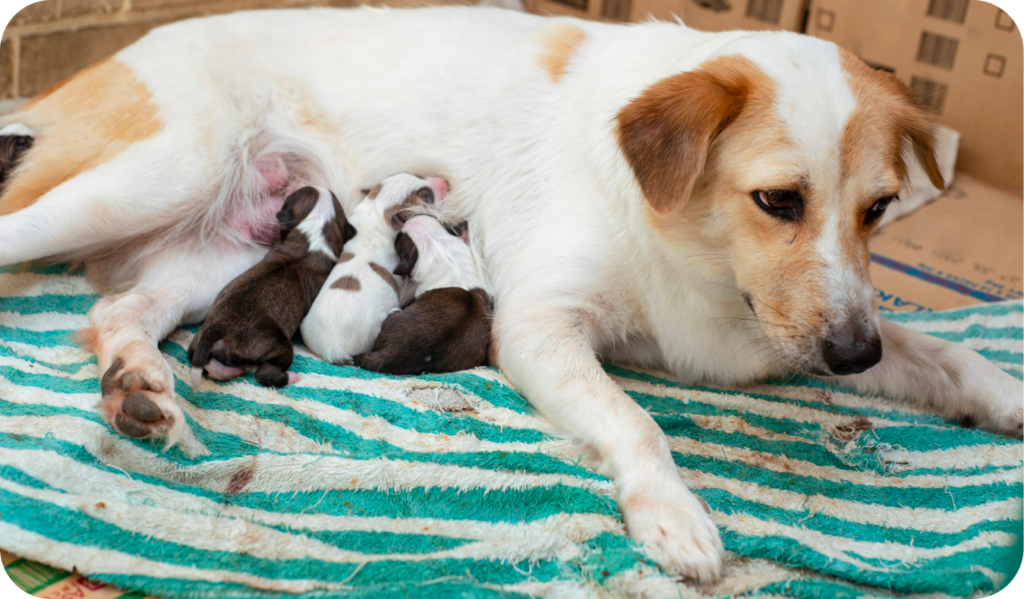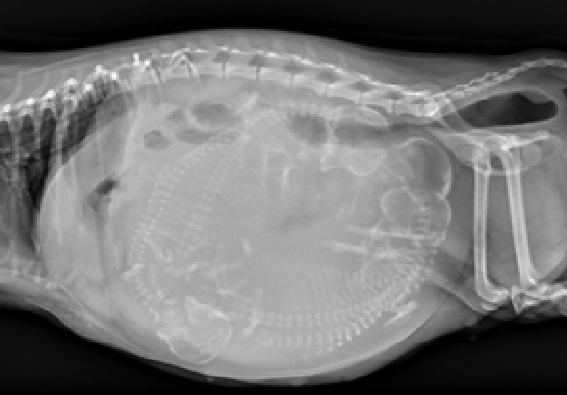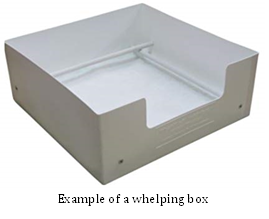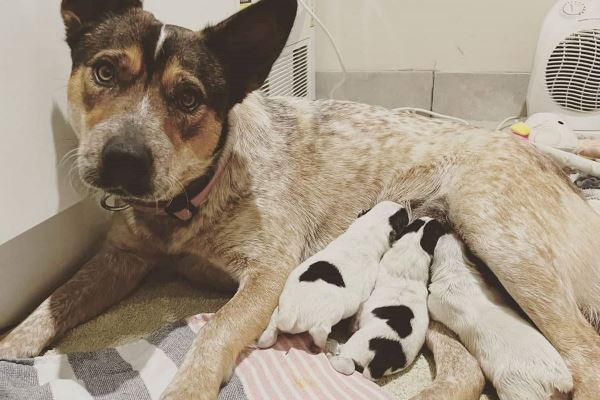Client Resources
Dog Pregnancy & Whelping

Pregnancy and whelping (when the puppies are delivered) can be a stressful time for everyone. We aim to give you the necessary information you need to help your dog and her puppies stay healthy and safe.
A dog’s pregnancy is approximately 9 weeks long. Confirmation or diagnosis of pregnancy can be made from 4-5 weeks onwards using ultrasound. Ultrasound scans are non-invasive and harmless to the bitch and puppies. When interpreting ultrasound scans, it can be hard to keep track of which puppy is which due to the narrow scanning field and mobile internal organs. Ultrasound is therefore better for confirming early pregnancies, and determining heartbeats, but not for determining litter size.
For estimations on litter size, we recommend an x-ray close to the end of the pregnancy, e.g. week 8 or 9. X-ray is only possible at the end of the pregnancy due to skeletal calcification of the puppies. Before week 8 of gestation, their skeletons are not formed enough to be seen on x-ray. At week 8-9 of gestation the puppies will be developed enough that there is minimal risk to their development.

Pre-whelping x-rays are important so that you can have an estimate of litter size when it comes to whelping. If your bitch starts to have her puppies and her labour seems to stop after 4 puppies when you are expecting 6 puppies, then you will know you need veterinary advice.
Similarly, a post-whelping x-ray can be important to help confirm that ALL puppies have definitely been delivered. Pre-whelping x-rays provide us with only an estimation of litter size. While we try to be as accurate as we can, if puppies are positioned so that their skeletons overlap on the x-ray image, then our estimation may be incorrect by 1-2 puppies.
We recommend that all adult dogs (male and female alike, desexed or entire) are given a multi-strain vaccine once a year to help protect them again several common viral diseases. In pregnant dogs, their immunity passes to their puppies to help protect them during their first weeks of life. Ideally, breeding bitches should have their vaccinations up to date before they are mated (before pregnancy starts). If you find that your dog is pregnant and her vaccinations are not up to date, unfortunately it is not safe to vaccinate her during her pregnancy, and her booster will need to be given after the puppies are born.
![]()
Appropriate diets are extremely important for lactating bitches (producing milk to feed her puppies). We recommend that all pregnant bitches are fed a high quality puppy food from the last 2 weeks of gestation through to after the puppies are weaned (not feeding on Mum’s milk anymore). Puppy food is higher protein, fat and calcium compared to adult foods. It takes a lot of energy and calcium to produce milk, and puppy food is important to provide your bitch with the energy and calcium she needs to produce milk safely for her puppies. Dogs that are not on puppy food are at risk for hypocalcaemia, excessive weight/condition loss and poor milk volume production. Hypocalcaemia is a potentially life-threatening disease caused by low blood and tissue calcium levels. Calcium is not only important in bones, but is also a key factor in muscle contraction including heart muscle. Hypocalcaemia can cause weakness, panting, muscle tremors, and severe heart arrhythmias, and is a veterinary emergency requiring life-saving treatment.
We recommend Hill’s puppy dry or wet foods for pregnant and lactating bitches, as well for growing puppies.
![]()
Parasite prevention for your dog is very important in ensuring that your puppies stay as healthy as possible. All pregnant bitches should be given an intestinal worming treatment within 2 weeks of whelping, and then every 3 months ongoing for life. Intestinal parasite infections can be transmitted from mother to puppy via placenta or milk, so treating the bitch for intestinal parasites helps to avoid her puppies also being infected in the early weeks of life. Intestinal worms feed off blood via the intestinal tract, and can cause nutritional absorption problems.
![]()
It is also important to treat your dog regularly for fleas and other external parasites. Fleas, like intestinal parasites, also feed on blood, and while an adult dog may become itchy from flea infections, they are unlikely to become unwell. This is simply due to their body size. Flea infections will only result in a comparatively small amount of blood loss in a normal adult dog. Puppies, however, only have a very small body mass, so any blood loss is very significant to them.
Fleas and intestinal parasites can cause severe anaemia in young puppies, and can be life threatening.
It is important to prepare your home environment for the arrival of new puppies. Creating a safe, draught-free, easily cleanable area for your bitch and her puppies to live in is important to avoid infections, gut disease and puppy deaths. A whelping box should be provided to help contain the newborn puppies. A whelping box is an open bed with raised sides that allows the bitch to come and go as she pleases but keep the puppies contained and safe. The whelping box should be positioned in an area that the bitch feels safe in. Some bitches will nest in hidden places in the house such as wardrobes, between or under furniture, certain rooms in the house, etc. Try to place the whelping box in the area that your bitch is likely to want to go to when she seeks comfort or safety.
Line the whelping box with newspaper, absorbent puppy pads, clean towels and blankets.
The temperature of the whelping box should be monitored to ensure that puppies are not getting too hot or cold. Newborns are unable to regulate their own temperature, and rely on environmental temperature to keep them at normal body temperature. This may be snuggling up to their mum, sleeping on bedding with a heat-mat or hot water bottle underneath, or sleeping under a heat lamp. The should be an area in the whelping box with no added heat sources that the puppies can crawl to if they get too warm. Depending on the time of year, you may need extra heat sources (e.g. if in winter). The ambient temperature of the whelping box should stay about 35-37 degrees.
The bedding of the whelping box should be changed and cleaned every day.

There are some behavioural changes that you may notice in the two weeks leading up to whelping. Observing these changes may help you predict when your dog is about to have her puppies, and allow you to be prepared.
Pregnant bitches may show reduced interest in food in the two weeks leading up to whelping. She may completely refuse food and pant despite resting in the 24 hours leading up to whelping. Some dogs will vomit in the early stages of labour. These signs may not occur in all dogs. She may seem unsettled and restless, or try to nest and hide. Some dogs will actively seek out their owner and want comfort, while others prefer seclusion.
You may see some discharge from her vulva in the days leading up to whelping. There is a mucus plug that develops in the cervix during pregnancy, which must break down prior to whelping.
Body temperature will often drop in the 24 hours leading up to whelping. If you are comfortable taking your dog’s temperature regularly then this can be a good indicator for whelping. Writing down your dog’s progressive temperature over the course of a couple of days can help you identify a pattern. Temperature changes up and down between 37.5˚C and 39.0˚C can be normal, but temperatures that continue to drop (approaching 37.0˚C) could be an indication that labour will soon begin.
Green discharge will often be seen during the whelping process. This may seem very strange and alarming to us, but the green pigment is normal in dog and cat placentas.
The bitch will normally bite or chew at the umbilical cords of her puppies to remove their placentas (if not separated already). Many bitches will also eat the placentas after they have been expelled. This is a normal behaviour. However, if your dog doesn’t remove the placentas from her whelping area, this is also normal and not harmful.

Sometimes human intervention is needed, especially with first-time mums. We recommend that people intervene with whelping as little as possible, but there are some circumstances where help is needed.
If a pup is born inside its foetal sac and your dog doesn’t remove it, then you will need to intervene. Gently pull the sac open to release the fluid, allowing the puppy to breathe. If your dog does not break the umbilical cord, then use clean cotton thread to tie off the cord tightly and cut it with clean scissors.
![]()
Certain circumstances can arise when a veterinary examination and intervention is needed. You should contact your vet and arrange an examination immediately if:
- You are concerned that your bitch is straining without producing a puppy, or that a puppy is visibly stuck
- If your bitch produces fewer puppies than you are expecting (e.g. expecting 6 puppies, but only 4 produced) and she does not appear to be in active labour
- If it has been longer than two hours between puppies
Sometimes an examination, assistance by hand, and medication is all that is needed. Sometimes a caesarean may be required if a puppy is truly stuck, or the uterus is completely fatigued. Statistically 1 in 5 bitches will need a caesarean.

